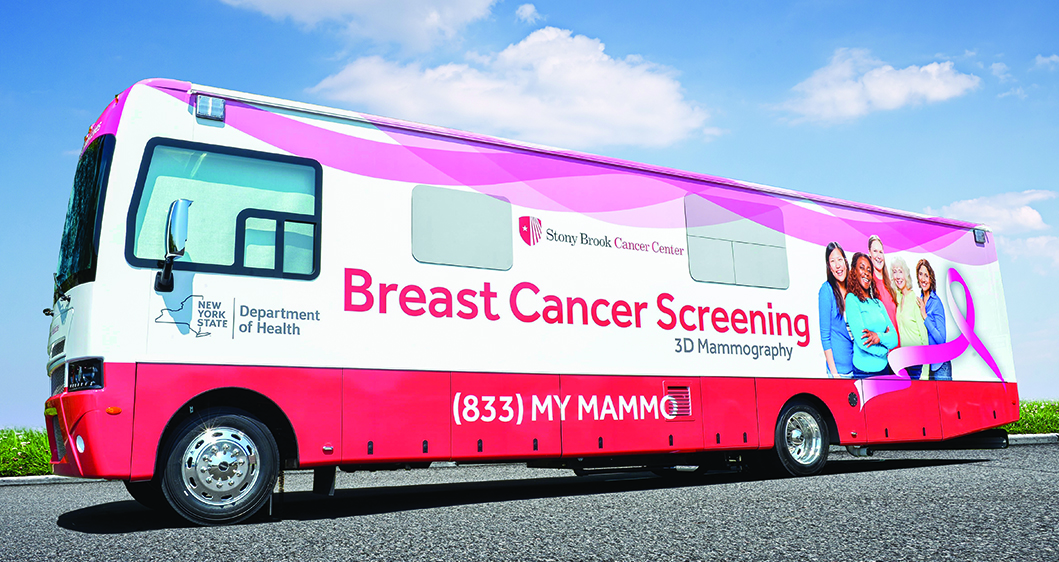Who should be screened for breast cancer?
Early detection of breast cancer offers the best chance for long-term survival. Mammography is capable of showing changes in the breast years before a patient or clinician is able to feel them. The Carol M. Baldwin Breast Care Center and Stony Brook Cancer Center, in accordance with the American College of Radiology guidelines, recommend screening mammography every year for women, beginning at age 40.
Who has a higher risk of breast cancer?
Women with a family history of breast cancer, Black/African American women, and women of Ashkenazi Jewish descent should be evaluated starting at age 30 to determine if they are at a higher risk. Other risk factors can include: a known genetic mutation such as BRCA1 or BRCA2, history of breast cancer, or history of chest radiation before age 30. Speak to your doctor about being evaluated if you think you may have a higher risk of breast cancer.
How is a mammogram performed?
Mammograms are done on an outpatient basis and usually take about 30 minutes to complete.
A radiologic technologist will conduct the mammography and will help position your breast in the mammography unit. Your breast will be placed on a special platform and compressed with a clear plastic paddle. Your breast will gradually be compressed; this is necessary in order to obtain the clearest image possible and detect small abnormalities that could be hidden by overlying breast tissue. It is important to hold very still during your mammogram and you may be asked to hold your breath for a few seconds while the x-ray picture is taken to help ensure a clear image. Several views are taken from different angles.
This process will be repeated for the other breast.
The American Cancer Society offers the below suggestions to prepare for the mammogram:
- Schedule your mammogram when your breasts are not tender or swollen to help reduce discomfort and get good pictures. Try to avoid the week just before your period.
- On the day of the exam, don’t wear deodorant or antiperspirant. Some of these contain substances that can show up on the x-ray as white spots. If you’re not going home afterward, you might want to take your deodorant with you to put on after your exam. The Carol Baldwin Breast Care Center can also offer you deodorant removal pads prior to the exam and deodorant after the exam if needed.
- You might find it easier to wear a skirt or pants, so that you’ll only need to remove your top and bra for the mammogram.
- Discuss any recent changes or problems in your breasts with your health care provider before getting the mammogram.
Scheduling a screening mammogram:
To make an appointment for your annual screening mammography, or a mammography and/or Breast MRI ordered by your doctor, call (631) 638-2121.

If you are a woman age 40 or above, you may be able
to receive your screening mammography on
Stony Brook’s Mobile Mammography Van.
Call (833) MY-MAMMO or
visit cancer.stonybrookmedicine.edu/Patients/MammoVan
When Cancer Is Found
Both surgeons and radiologists review all imaging for our patients with cancer, for a collaborative approach to diagnosis and treatment regimen. To learn more about the Breast Cancer team, click here.
For an appointment with a doctor on the Breast Cancer team, call (631) SB-CANCER (722-2623).
Breast Imaging Center of Excellence Designation
The American College of Radiology (ACR) has recognized the Carol M. Baldwin Breast Care Center as a Breast Imaging Center of Excellence. This designation recognizes our accreditation in mammography, stereotactic breast biopsy and breast ultrasound (including ultrasound-guided breast biopsy).
For more information about Stony Brook Medicine's Advanced Imaging Center, click here.

